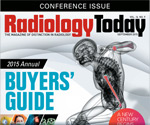 |
The prevalence of traumatic brain injury (TBI) among military personnel in combat settings is startling. According to the Institute of Medicine, 20% to 23% of American soldiers, sailors, and airmen in Afghanistan and Iraq suffer TBI. As long as this country puts its personnel in harm’s way—and politics aside, to some extent that must happen—treating TBI in those who serve our country is a must. Prompt imaging and treatment seems like a reasonable place to start, and is the topic of this month’s E-News Exclusive.
— Jim Knaub, editor |
 |
 |
How Early MRI Could Improve Traumatic Brain Injury Care
Between one-fifth and one-fourth of military personnel serving in Iraq and Afghanistan sustained a traumatic brain injury (TBI) during their service, according to the Institute of Medicine. Neuroimaging physicians at Walter Reed National Military Medical Center in Bethesda, Maryland, believe earlier MRI imaging of those patients might someday lead to better outcomes among afflicted servicemen and women.
Full story » |
 |
 |
Ready or Not, ICD-10 is Here
ICD-10 will finally arrive on October 1, 2015, and there are several key areas that radiologists should take special notice of in order to ensure proper documentation and reimbursement. Read more »
Radiology Apps
While they won’t replace full workstations, a variety of apps are available for radiologists to use on their Android and Apple devices to help make their jobs easier and more efficient. Read more »
Bring More Meaning to Meaningful Use
Organizations with a myopic view of meaningful use are likely to struggle to meet new objectives and gain little from those they do attain. Read more »
2015 Annual Buyers’ Guide
Our annual directory of the latest imaging products and services is here. Read more » |
 |
|
|
 |
“COPD is a very heterogeneous disease. Patients are classified based on spirometry, but patients with the same air flow may have different symptoms and significant variation in how much regular activity they can perform, such as walking to their car or up the stairs in their home.”
— Grace Parraga, PhD, from the Robarts Research Institute in London, Ontario, Canada, discussing the benefits of including imaging when diagnosing patients with COPD |
 |
|
